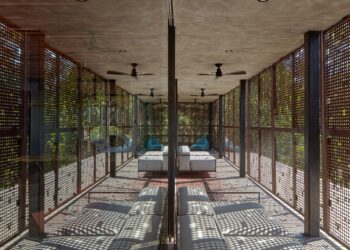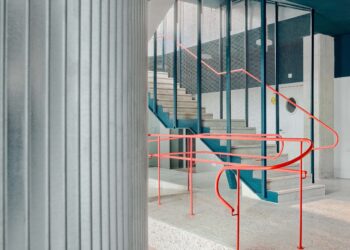An environmental center in Alicante’s Vía Parque
근 미래에 알리칸테주 농업의 중추가 될 비아 파케 도시 환경관측소

The ‘Observatory for the Urban Environment’ is the result of a competition by Alicante City Council in 2009. The proposal was to place in Vía Parque (an important reserve of green space in the city) environmental equipment demonstrating the city’s recent interest in sustainable development.
However, the city of Alicante is not exactly known its environmental commitment, on the contrary, insensitive speculative developments there have tainted the beauty of Spain’s coastline. Occupying a plot of the Vía Parque and losing part of its valuable green space did not seem to the architects like a good way to start to reverse this situation.
스페인 남동부, 지중해 연안에 위치한 알리칸테는 발렌시아 지방 제2의 도시이자, 스페인에서 여덟 번째로 큰 도시다. 예로부터 온화한 날씨와 풍성한 자원덕에 농업과 관광업이 두루 발전해왔다. 그러나 근래에 들어서는 개발과 성장에만 지나치게 초점을 맞춘 탓인지, 도시 개발 과정에서 환경에 대한 측면은 거의 고려되지 않았다. 이러한 상황이 지속되자 시 당국도 문제점을 인식했고, 이제는 알리칸테도 달라져야 한다는 것을 보여주기 위해 새로운 프로젝트를 계획했다. 알리칸테의 중요한 녹지공간인 ‘비아 파케’에 도시 환경관측소를 만들어 지속가능성에 대한 의지를 보여주기로 한 것이다. 이를 위한 공모전이 2009년 개최됐고, 당선작으로 선정된 그루포 아라네아의 작품이 오랜 준비를 마치고, 2018년 마침내 시민들과 만나게 됐다.





The designers’ first idea therefore was, not only not to lose a single square meter of the park, but to multiply its surface instead.
The resulting center generates its own landscape, permeable and protected, and offers a stop on the walk along the Vía Parque: shade that tempers the harsh summers and a cool patio. On its ascending route it raises the level of the park and offers a new way to enjoy it as a floating, covered park, where the services of the observatory are mixed with green spaces. Its landscaped roof completes the range of routes. The infrastructure is capable of generating multiple situations and uses, flexible, vivid and ‘invaded by green’.
The observatory program includes: a large conference room accessed directly from the park; an environmental library accessed directly from the park and whose staggered configuration allows connection with the floating park; an outdoor reading room (the climate of the city of Alicante allows this outdoor use almost all year round); a reconfigurable exhibition space; four environmental classrooms that can be reconfigured into a large continuous classroom; a series of offices where the Environment Area of the Alicante City Council will be installed; a central cistern that collects rainwater from the plot and a pre-existing irrigation reservoir.



알리칸테가 무분별한 개발로 지중해 연안의 아름다운 경관을 해치는 것으로 악명 높았던 만큼, 환경관측소 설치라는 명목 하에 도시의 소중한 녹지 공간에 손을 댄다는 점 자체를 부정적으로 보는 시각들이 있었다. 때문에 건축가는 두 가지 목표를 세웠다. 첫째, 공원의 기존 녹지를 전혀 해치지 않을 것. 둘째, 현 상태의 보존에서 한걸음 더 나아가, 녹지를 확장하는 것이다.
속이 훤히 들여다보이는 개성 있는 실내 정원을 만들고, 뜨거운 여름을 식혀줄 수 있는 그늘과 시원한 스페인의 중정을 마련해 공원을 산책하는 도중 쉬어 갈 수 있는 공간을 마련했다. 그 위로는 기존 공원의 자연 상태보다 높은 새로운 지형에 식물 보호소, 환경 생태 실, 빗물 호수 등이 포함된 환경 장비와 녹지 공간을 통합하여 공중 정원을 조성했다. 환경관측소를 품은 공중 정원을 향한 오르막길을 통해 색다른 방식으로 공원을 즐기며, 다양한 상황과 용도로 활용할 수 있는 융통성 있는 공간이다.


The infrastructure is made up of two concrete slabs that work as a deep beam when connected through a series of metal pillars, taking advantage of the slope of the land to allow a slight movement to rise and pass underneath. Two levels of lightened slabs and lattices function as flexural connecting beams, in addition to the existing concrete cores. This makes it possible to achieve large spans and free up the ground floor, allowing the park to flow more freely under the building.
The roof and a large part of the building’s slabs are landscaped, creating large open and covered garden areas. The enclosures are mostly made of glass, with large practicable areas (to promote ventilation and allow connections with the floating park), protected by a permeable plant façade. This offers thermal and acoustic insulation, filtering impurities and completing the sensory experience of the center.
‘Plant Asylum’, ‘Environmental Confessional’, ‘Rain Lake’, ‘Urban Gardens…’ the observatory is also part of a network of agricultural spaces to be introduced throughout the city of Alicante in the near future.


환경관측소는 대형 회의실, 환경 도서관, 외부 열람실, 전시 공간, 하나의 커다란 교실로 변신이 가능한 4개의 교실, 시의회 환경부 사무공간, 그리고 빗물을 수집하여 전망대에 필요한 물을 공급하는 중앙 저장 물탱크 및 기존 관개 저수지를 품고 있다. 그중 환경 도서관은 공중 정원과의 연결성을 확보하기 위해 지그재그로 쌓아 올렸다. 외부 열람실은 알리칸테의 겨울은 온화하고 여름은 뜨거우면서 강수량이 적은 기후 덕분에 일 년 내내 사용이 가능하다.
일련의 철근 기둥이 지탱하고 있는 두 개의 콘크리트 슬래브는 널찍한 보의 역할도 하며, 부지 경사를 반영한 자연스러운 곡선을 형성하고 있다. 이 갈라지는 두 층의 경량 슬라브를 통해 1층의 콘크리트 코어를 제외하고 구조물을 최소화하여 자연스러운 연결 동선과 함께 공원의 시야를 확보했다. 지붕과 건물 슬라브 대부분 공간에도 조경을 조성하고, 환기를 촉진하고 공중 정원과의 연결성을 유지하기 위해 대부분 벽은 유리 또는 덩굴 식물로 구성했다. 이를 통해 단열 및 방음, 그리고 불순물 제거 효과를 얻었을 뿐만 아니라 싱그러운 산책로가 탄생했다.

Project: Observatory of the Urban Environment / Location: Vía Parque, Alicante, España / Architect: grupo aranea / Landscaping: Marta García Chico / Project manager architect: Francisco Leiva Ivorra / Project execution: Luis de Diego Fort / Landscaping: Marta García ChicoStructure: José Carrasco Hortal / Partners: José Luis Carratalá Rico(Arquitecto Técnico); Martín López Robles, Ágata Alcaráz, Andrés Llopis, Luis Navarro Jover, Marian Almansa Frias(Arquitecto); JoseLuis Romeu Lamaignére(Ingeniero Agrónomo)Facilites and services: Juan Jesús Gutiérrez / Client: Alicante City CouncilConstructed area: 1,200m² / Garden area: 9,000m² / Cost: EUR 1,209,633 / Design: 2010 / Construction: 2012~2017 / Completion: 2018



































